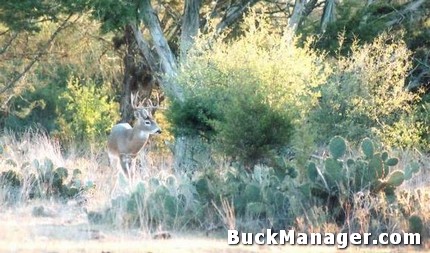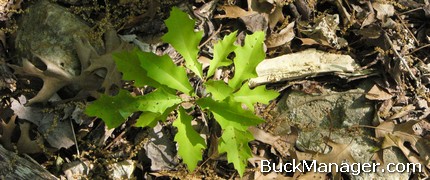Managing for good white-tailed deer habitat on a property is the key to maintaining a healthy deer herd. Plain and simple, deer in good body condition are more productive than deer in poor condition. A problem many landowners face is that Mother Nature does not always do her part. This is the major reason why supplemental feeding has become an integrated part of deer management on many ranches.
A property can generally have good deer habitat, but that does not necessarily mean that the plants found on the property are in good condition. Rainfall makes a big difference from year to year. In fact, research conducted in South Texas, on what was coined the “South Texas Buck Project,” by the Caesar Kleberg Wildlife Research Institute at Texas A&M-Kingsville found that spring rains explained 70% of the year to year variability in buck antler size.

Spring rain and antler growth were highly correlated, meaning bucks grew larger antlers following wet springs and smaller antlers following dry ones. During the South Texas Buck Project, researchers classified spring rains as those occurring during March, April and May. And over much of the whitetail’s range, it is during this time of the year when good rainfall can produce bountiful crops of high protein forbs and set up browse plants for the long, hot, and typically dry summer. If the rains do not arrive, then deer can forget about the would-be protein buffet.
Okay, so I will admit that South Texas is much different than many parts of the white-tailed deer’s range, including most parts of Texas, but the results of this study are a bit staggering. The data collected during the South Texas Buck Project conclusively found that spring rains alone accounted for as much as a 20 inch shift in gross Boone and Crockett scores for mature bucks! These findings really illustrate the importance of precipitation, habitat condition and food availability to any landowner or hunter interested in deer management.

So this all makes enough sense, but how can it help hunters on their property given that they can not control the rain? Well, no one can turn on the faucet that makes it rain, but hunters can control whitetail food availability through management practices such as maintaining proper livestock grazing rates, brush management, prescribed burning, supplemental feeding and managed deer harvest. Allowing deer to grow older is one way to produce more mature bucks, but age is not the only factor that affects antler size.
In mature bucks, rainfall determines whether that 20 inch shift I mentioned previously ends up being 20 inches up or 20 inches down. Food availability is of utmost importance in allowing old bucks to reach their genetic potential. For hunters interested in trophy buck management, I would seriously considering shooting any buck 5 1/2 years of age following a wet spring. Why? For the simple reason that the chances of getting two good years in a row are slim, and therefore antlers are not likely to be better the next year. During a dry spring, such as this one, hunters may want see if those deer can add that 20 inches back on next year.
We saw some great bucks last year thanks to the spring/summer rain. This year looks to be poor is comparison. Deer are starting to run through the protein, so some rain would be nice to help the plants.
Great informative post on antler growth. Mother Nature has been pretty brutal to us here in South Texas this year. Our land is usually pretty good deer country (i.e. good natural habitat with plenty of forage) but here lately our deer have been hitting up the protein and supplemental feed. We were particularly worried about our one-year old bucks, but they look pretty good, especially considering the circumstances. Overall our other bucks also seem to be doing ok too.
What would you do? We have 250 whitetail: 88 bucks and 145 doe. Lots of spikes, 4, 6, 7, and 8 point bucks. Several hunters, POA hunting ranch with 46 hunting lots. Some wish to harvest mature bucks only, others wish to manage the poorer 2 1/2+ year old bucks of lower quality.
I say we shoot out our poor genetics such as spikes, no brow tines, 4’s through to basket 8’s from 2 1/2+ to mature. We protein feed all year and have several stock tanks. We average 18 to 20 bucks per year. This could wipe out our top end bucks.
Donne, I don’t know how many acres you are talking about here, but I would first recommend getting the deer population in line with the available habitat. Considering the addition of supplemental feed, I would guess that this is somewhere between 1 deer for every 5 to 8 acres. The buck to doe ratio seems good, so there is no need to change anything there.
As far as buck harvest, if you want to maintain older aged bucks on the property then never harvest more than 20% of the buck population. This harvest should include, like you said, spikes and 4 point yearlings (1 1/2 year old bucks). It should also include all bucks without brow tines, 3 1/2+ year old bucks with 7 or fewer antler points, 4 1/2 year old bucks with 9 or fewer points, and any buck 5 1/2+ years old.
At 5+ years old it does not matter whether a buck is good or bad, it’s old enough that it should be harvested. Buck harvest should be spread across all age classes and based on both age and antler characteristics if you want to improve the overall buck quality.
Sorry, that was important info. We have 1,023 acres. Our latest deer survey was 3 days ago and the average number of animals over 3 counts, established by the TP&W biologist, was:
Bucks = 28
Does =51
fawns= 13
Unidentified= 7
This equates out to 297 deer. Thanks for the info.
Donnie, then according to your numbers you have an estimated population of 90 bucks, 167 does and 42 fawns on 1,023 acres. That is at least 100 too many deer. If you add the fawns (42) into the buck and doe numbers you end up with about 111 bucks and 188 does.
In urban or suburban environments, maintaining the deer population at a manageable level is typically the number one goal. The best way to control deer numbers is to remove does. I’d look at keeping a base doe herd of about 90 animals. This means about 98 does should be harvested this season.
In addition, based on the situation you’ve outlined, the improvement of antler characteristics is probably not the most important factor, but maintaining good buck age structure is important for hunters and the deer herd. I’d suggest a winter carry over number of 80 bucks. This means the property currently has 31 too many bucks.
This is about 1/3 of the current adult buck population, but the simple fact of the matter is that the total number of deer on the property is too high. If possible, I would stick to strict buck harvest criteria as mentioned in my previous comment.
The suggested harvest would leave about 90 does and 80 bucks on the property, or about 1 deer for every 6 acres. Plenty of deer, much more healthy situation, less ornamental yard damage, better fawn production and consuming less feed. You can then expect about 30 to 70 fawns to be produced each year… the same as the total of bucks and does you will need to remove each year to keep the deer population at a constant 170 animals.
Donne, I think Buck Manager’s guidelines are EXACTLY what you should do. Those are excellent suggestions and I would follow them exactly as he lined out.
Your biggest problem will be convincing those you hunt with to take out that many does. There does not seem to be many does harvested yearly…but as Buck Manager stated, it’s essential for the overall health of the herd.
I can tell you the many run-arounds we did with landowners and others that were leasing when it came to shooting does. The most common reasons were that they either didn’t like shooting does or they believed that leaving more does meant growing more bucks.
I guess you and your guys have a decision to make. Do you want MORE bucks or BIGGER bucks. We had to do that very thing. We killed so many does that we thought we had shot every one on the property. After we had taken out about 160 does in 2 seasons (on 1,000 acres) we noticed that the bucks’ body weights and antlers were getting bigger. The bucks went from weighing 160 lbs to over 200 lbs live weight.
The reason – all the extra does had been eating all the highly desired forbs. Your deer don’t eat ONLY protein feed. It only accounts for about 20-30% of their diet on average. They still forage for other foods. The lower the deer density, the more highly quality forbs that will be available to your bucks…and thus the bigger the racks.
It takes discipline and a few years of doing things you don’t want to do (like shooting 5 or more does at one time), but it will pay off.
As the brilliant man Jim Rohn said about those people who either suffer from the pains of discipline or regret…”The difference is discipline weighs ounces while regret weighs tons.” Discipline yourself to do what you have to on the lease to get your deer density down… or have regret 5 years later and think about the what-could’ve-been’s.
I know that if the spring rains don’t come then you have a rough year in South Texas. What are the names of the primary high protein plants or shrubs that the deer depend on for good antler growth?
Gary, South Texas is loaded with brush/browse plants for whitetail deer. This is one of the reasons why deer do so well in the region. Browse plants provide good protein levels year-in and year-out, but the new growth on these plants is particularly nutritious. The more it rains the more new growth the deer get. Here are the major browse plants of South Texas: Browse 1 & Browse 2.